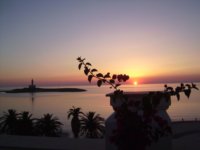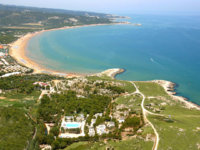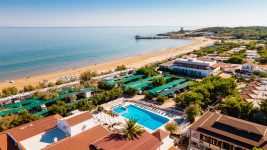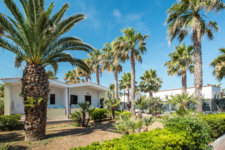Monte Sant'Angelo is a village located in the southern part of the Gargano, at about 800 meters above sea level, known above all for the Sanctuary of San Michele Arcangelo, a Unesco heritage site.
In addition to the sanctuary, the medieval quarter of the Junno district is also worthy of note, with its very narrow alleys and white terraced houses with sloping roofs. Monte Sant'Angelo is one of the villages that have best preserved the typical culture of the Gargano.
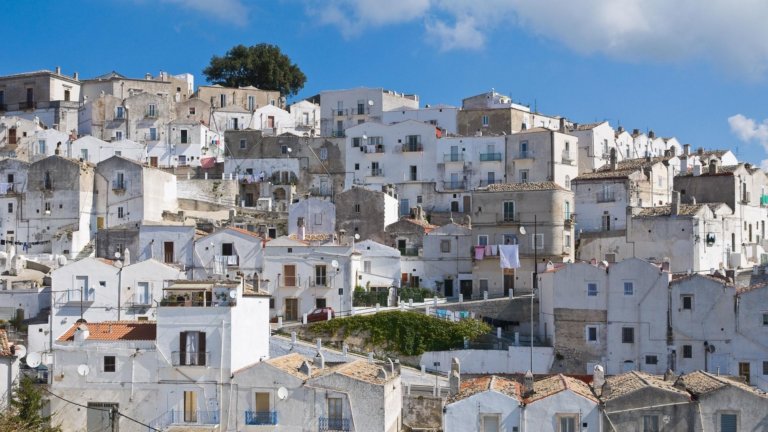
The Sanctuary of Monte Sant'Angelo, in the historic city centre, is a very ancient place of worship.
Over the centuries there have been many pilgrims who have visited, among them numerous Popes and sovereigns.
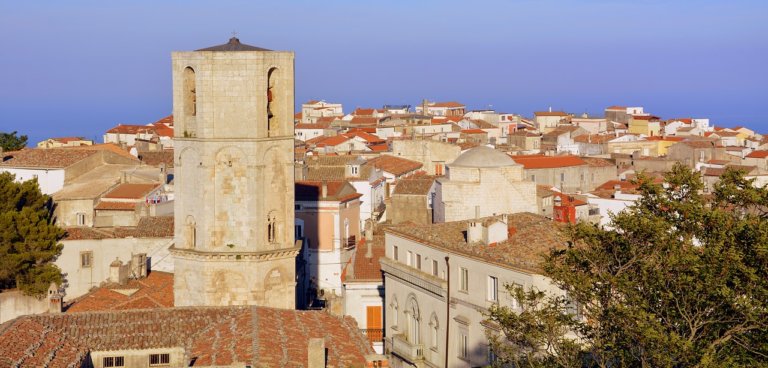
The whole is part of the serial site "The Longobards in Italy, Places of Power, 568 - 774 AD", inscribed on the UNESCO World Heritage List in June 2011.
Several apparitions of the Archangel Michael are linked to the sanctuary, the first being the one dated 490, when Elvio Emanuele, a wealthy gentleman from the Gargano, found a previously lost bull from his herd inside an inaccessible cave. He then tried to kill him, but the arrow came back, wounding Elvio, who went to Lorenzo Maiorano, holy bishop of Siponto, to tell what had happened. After listening to him, the bishop called for three days of prayer and penance at the end of which St. Michael the Archangel appeared to him in a dream to ask him to dedicate the cave to Christian worship, which happened on 29 September 493, after 2 other appearances. A fourth apparition took place in 1656 when the city of Monte Sant'Angelo defeated the plague.
The Pilgrimage to the Sanctuary, widespread for many centuries, is very frequent from Vieste, from time immemorial the faithful every end of September set out from Vieste on foot to reach, through the Umbrian forest, the Michael sanctuary on the morning of 29 September. Other groups leave instead from San Marco in Lamis and from Manfredonia. Tradition has it that San Michele also appears on the Gargano in another cave, near the Varano lake.
St. Michael, also venerated by Jews and Muslims, is the symbol of the fight of good against evil.
Some historians have found strong similarities between the Christian figure of San Michele and the pagan one of Heracles / Hercules, a myth linked to sheep farming and transhumance.
The figure of Hercules in turn has many points in common with the sylvan semi-divinity of the giant Gargan, revered by the Celts.
The centrality of the figure of the Archangel Michael is testified by the fact that the Lombards, who settled in the area and then converted to Christianity, identified the Archangel as one of their main divinities: the god Thor.
These legends highlight some aspects of this land and its deep relationship with the sea, with nature and influenced by many cultures (Greco-Roman, Byzantine, Longobard).
The Sanctuary of San Michele Arcangelo
The Sanctuary of San Michele Arcangelo of Monte Sant'Angelo is a place of great historical and emotional importance for all pilgrims devoted to San Michele. The basilica consists of an upper and a lower level. The upper level includes the Romanesque portal and the bell tower, while the lower level instead includes the cave, which can be reached directly via the Angevin staircase, a devotional museum and crypts.

The construction of the bell tower, erected by Charles I of Anjou as thanks to San Michele for the conquest of southern Italy, began in 1274. The tower, designed by the architect Giordano, has an octagonal shape following the scheme of the towers of Castel del Monte and was completed in 1282 with an original height of 40 metres. However, it was later reduced to its current 27 meters, probably due to lightning or to place the bells more easily. The bell tower is divided into four floors with blind round arches, with variously decorated frames. Inside there are three domed cells and a last cell with pointed arch ribs. On the top floor there are 5 bells that look out from four arched openings, the largest of which, the sixth, dates back to the year 1666. Passing next to the bell tower, you enter a large square called the "Upper Atrium" and bordered from a colonnade with railings. The prospectus of the entrance dates back to 1865 and consists of two pointed arches, surmounted by a triangular pediment decorated with friezes. At the top, between two small rose windows, there is an aedicule with the statue of San Michele Arcangelo. The left entrance is embellished by a bronze door with historiated panels showing the entire history of the Sanctuary, from its origins up to the pilgrimage of John Paul II in 1987. At the top, in correspondence with the doors, there are two rectangular tombstones, one of which bears an inscription engraved with the words spoken by the Archangel in the third apparition. Under each tombstone there is a pointed arch portal, the most precious of which, on the right, dates back to the XNUMXth century.

The entrance to the sanctuary takes place through the portal on the right and, as soon as you cross the door, you are immediately projected into an incredible medieval setting: an enormous staircase (from the Angevin period) dug directly into the rock descends precipitously towards rooms devoid of light, almost dark, whose walls are all frescoed with figures of saints, merchants and knights. These images are accompanied by hundreds of sentences written in ancient languages; remote messages and quotations (greetings, invocations, prayers) that retrace a historical excursus from the dawn of Christianity to the age of the "enlightenment", letters and complete words often flanked by incomprehensible engravings depicting hands. 
Further down, on the left, appears a trefoil canopy with twisted columns containing the marble statue of a Madonna whose black eyes are extraordinarily expressive. The long stairway (86 steps) ends in an atrium, in the inner part of the Sanctuary: on the left there is the entrance to the Museum and on the right there is a small porticoed courtyard on the edge of which runs a loggia; to the right and to the left, ancient sarcophagi containing the mortal remains of noblemen and prelates. Opposite is a stairway formed by six semicircular steps which lead to a large marble portal of Romanesque workmanship with two enormous bronze doors (made in Constantinople in 1076).
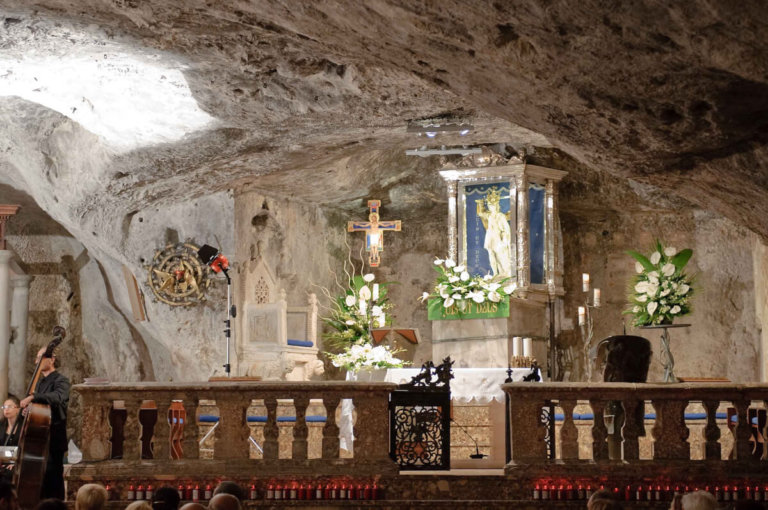
The cave of San Michele Arcangelo
The most mysterious part of the Sanctuary is certainly the cave, where tradition has it that the Archangel Michael appeared. Inside the cave, where it is forbidden to take photos and videos out of respect for the pilgrims and devotees who pray there, there is a Gothic nave divided into three bays and closed by a cross vault, with an altar of St. Francis and a cave. To the right are altars dedicated to St. Peter and the Crucifix, a royal throne carved in marble, various statues and bas-reliefs protected by transparent cases and an altar dedicated to the Madonna del Soccorso. There is also a small inlet in the rock called the Pozzetto, in which the "stilla" (the trickle of water that descended from the rock) was collected and the churchyard with an episcopal chair, a presbytery with the altar of the Archangel and a statue of the holy martyr Sebastian. In the 1507th century, Archbishop Domenico Ginnasio had the bottom of the natural cave excavated to create a larger presbytery. In the first decade of the seventeenth century, he enclosed an area of the cave with copper plates in the form of an altar. In 29, on the altar of the Impronte, a statue of San Michele Arcangelo was placed, a high quality work attributed to Andrea Contucci. The statue, carved in white Carrara marble, represents San Michele as a warrior trampling on Satan. The statue is known for its uniqueness in the history of sculpture and for the expression of the smile on the face of St. Michael. The statue's sword is carried in procession on XNUMX September.

Despite the centuries, the atmosphere of the place still maintains its strength and sacredness, managing to touch even the most skeptical. The history, beauty and spirituality of Monte Sant'Angelo have attracted many pilgrims over the centuries. Even today the Sanctuary of San Michele Arcangelo continues to be a place of great spiritual and cultural importance, a unique experience not to be missed.
What to see in Monte Sant'Angelo
The village of Monte Sant'Angelo, located in the southern part of the Gargano, offers a unique experience to its visitors. In addition to the famous Sanctuary of San Michele Arcangelo and the medieval quarter Rione Junno, the historic center of the village is full of timeless beauties.

The churches, such as those of the monumental complex of San Pietro, are examples of ancient art and architecture. Furthermore, the castle of Monte Sant'Angelo, the Castle of Monte Gargano dating back to the XNUMXth century, it is another must-see attraction.
During a visit to this village it is impossible not to admire the sea that bathes the gulf of Manfredonia from above, offering a breathtaking panorama.
The surroundings of Monte Sant'Angelo, the Umbra Forest, Bosco Quarto and the Pulsano Abbey
With an excursion to Monte Sant'Angelo you will also be able to explore the surroundings of this village, among nature, breathtaking views and terraced hills full of olive trees. Located north-west of Monte Sant'Angelo, between the village of San Michele and San Giovanni Rotondo, Bosco Quarto constitutes, together with the nearby Umbra Forest, constitutes the green lung of the Gargano. These woods offer visitors spectacular natural landscapes, once crossed by shepherds, wayfarers and pilgrims. In the past Bosco Quarto was known as the Bosco di Manfredonia, but was later called with its current name following the territorial subdivision of the woods. The Umbra Forest, located in the northernmost area, is the other Unesco site of which Monte Sant'Angelo can boast.
About 10 km southwest of Monte Sant'Angelo is the abbey of Santa Maria Pulsano, a XNUMXth-century monastic complex with characteristic hermitages carved into the rock, from which you can enjoy an incredible panorama of the gulf of Manfredonia. 

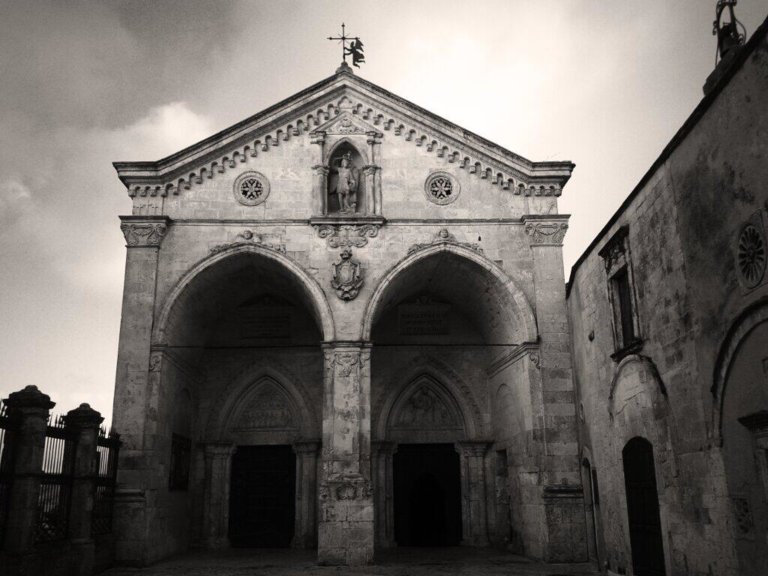





 Turismovieste.it is created by
Turismovieste.it is created by 



